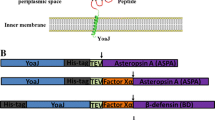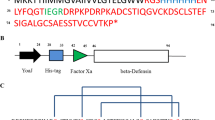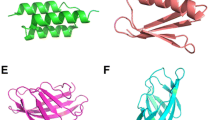Abstract
Protein disulfide isomerase is a type of enzyme that catalyses the oxidation, isomerization and reduction of disulfide bonds. Conotoxins that containing disulfide bonds are likely substrates of protein disulfide isomerise. Here, we cloned 12 protein disulfide isomerise genes from 12 different cone snail species that inhabited the sea near Sanya in China. The full-length amino acid sequences of these protein disulfide isomerase genes share a high degree of homology, including the same -CGHC- active site sequence and -RDEL- endoplasmic reticulum retention signal. To obtain enough conus protein disulfide isomerase for functional studies, we constructed the expression vector pET28a-sPDI. Conus protein disulfide isomerase was successfully expressed using Escherichia coli expression system and purified using chromatography method of affinity chromatography. The recombinant conus protein disulfide isomerase showed the ability to catalyse disulfide bond formation and rearrangement in the lysozyme enzyme activity assay. The role of conus protein disulfide isomerase in the in vitro oxidative folding of conotoxins was investigated using synthetic linear conotoxin lt14a, a peptide composed of 13 amino acids. It was confirmed by high performance liquid chromatography and mass spectrometry analysis that conus protein disulfide isomerase can catalyse the disulfide bond formation of linear lt14a. Then, conus protein disulfide isomerase was acted as a fusion partner during the production of engineered peptidyl-prolyl cis–trans isomerase and lt14a derived from cone snails. It was shown that peptidyl-prolyl cis–trans isomerase and conotoxin lt14a are successfully expressed in a highly soluble form by fusion with conus protein disulfide isomerase. Thus, conus protein disulfide isomerase functions not only as an enzyme that catalyses oxidative process but also a fusion partner in recombinant conotoxin expression.






Similar content being viewed by others
Abbreviations
- PDI:
-
Protein disulfide isomerase
- sPDI:
-
Conus protein disulfide isomerase
- HPLC:
-
High performance liquid chromatography
- MS:
-
Mass spectrometry
- PPIase:
-
Peptidyl-prolyl cis–trans isomerase
- LZM:
-
Lysozyme
- CD:
-
Circular dichroism
- SDS-PAGE:
-
Sodium dodecyl sulphate–polyacrylamide gel electrophoresis
- TRX:
-
Thioredoxin
- GST:
-
Glutathione-S-transferase
- IPTG:
-
Isopropyl β -D-1-thiogalactopyranoside
- MW:
-
Molecular weight
- PVDF:
-
Polyvinylidene fluoride
References
Lewis RJ (2009) Conotoxins: molecular and therapeutic targets. Prog Mol Subcell Biol 46:45–65. doi:10.1007/978-3-540-87895-7_2
Lavergne V, Harliwong I, Jones A, Miller D, Taft RJ, Alewood PF (2015) Optimized deep-targeted proteotranscriptomic profiling reveals unexplored Conus toxin diversity and novel cysteine frameworks. Proc Natl Acad Sci USA 112(29):E3782-3791. doi:10.1073/pnas.1501334112
Zhou M, Wang L, Wu Y, Zhu X, Feng Y, Chen Z, Li Y, Sun D, Ren Z, Xu A (2013) Characterizing the evolution and functions of the M-superfamily conotoxins. Toxicon 76:150–159. doi:10.1016/j.toxicon.2013.09.020
Buczek O, Bulaj G, Olivera BM (2005) Conotoxins and the posttranslational modification of secreted gene products. Cell Mol Life Sci 62(24):3067–3079. doi:10.1007/s00018-005-5283-0
Wang L, Tang W, Wang X, Chen Y, Wu Y, Qiang Y, Feng Y, Ren Z, Chen S, Xu A (2015) PPIase is associated with the diversity of conotoxins from cone snail venom glands. Biochimie 112:129–138. doi:10.1016/j.biochi.2015.02.024
Katiyar S, Till EA, Lennarz WJ (2001) Studies on the function of yeast protein disulfide isomerase in renaturation of proteins. Biochim Biophys Acta 1548(1):47–56
Benham AM (2012) The protein disulfide isomerase family: key players in health and disease. Antioxid Redox Signal 16(8):781–789. doi:10.1089/ars.2011.4439
Song JL, Wang CC (1995) Chaperone-like activity of protein disulfide-isomerase in the refolding of rhodanese. Eur J Biochem 231(2):312–316
Primm TP, Walker KW, Gilbert HF (1996) Facilitated protein aggregation. Effects of calcium on the chaperone and anti-chaperone activity of protein disulfide-isomerase. J Biol Chem 271(52):33664–33669
Bulaj G, Olivera BM (2008) Folding of conotoxins: formation of the native disulfide bridges during chemical synthesis and biosynthesis of Conus peptides. Antioxid Redox Signal 10(1):141–155. doi:10.1089/ars.2007.1856
Puig A, Gilbert HF (1994) Protein disulfide isomerase exhibits chaperone and anti-chaperone activity in the oxidative refolding of lysozyme. J Biol Chem 269(10):7764–7771
Kajino T, Ohto C, Muramatsu M, Obata S, Udaka S, Yamada Y, Takahashi H (2000) A protein disulfide isomerase gene fusion expression system that increases the extracellular productivity of Bacillus brevis. Appl Environ Microbiol 66(2):638–642
Nguyen MT, Koo BK, Thi Vu TT, Song JA, Chong SH, Jeong B, Ryu HB, Moh SH, Choe H (2014) Prokaryotic soluble overexpression and purification of bioactive human growth hormone by fusion to thioredoxin, maltose binding protein, and protein disulfide isomerase. PLoS ONE 9(3):e89038. doi:10.1371/journal.pone.0089038
Safavi-Hemami H, Gorasia DG, Steiner AM, Williamson NA, Karas JA, Gajewiak J, Olivera BM, Bulaj G, Purcell AW (2012) Modulation of conotoxin structure and function is achieved through a multienzyme complex in the venom glands of cone snails. J Biol Chem 287(41):34288–34303. doi:10.1074/jbc.M112.366781
Bulaj G, Buczek O, Goodsell I, Jimenez EC, Kranski J, Nielsen JS, Garrett JE, Olivera BM (2003) Efficient oxidative folding of conotoxins and the radiation of venomous cone snails. Proc Natl Acad Sci USA 100Suppl 2:14562–14568. doi:10.1073/pnas.2335845100
Wang ZQ, Han YH, Shao XX, Chi CW, Guo ZY (2007) Molecular cloning, expression and characterization of protein disulfide isomerase from Conus marmoreus. FEBS J 274(18):4778–4787. doi:10.1111/j.1742-4658.2007.06003.x
Safavi-Hemami H, Li Q, Jackson RL, Song AS, Boomsma W, Bandyopadhyay PK, Gruber CW, Purcell AW, Yandell M, Olivera BM, Ellgaard L (2016) Rapid expansion of the protein disulfide isomerase gene family facilitates the folding of venom peptides. Proc Natl Acad Sci USA 113(12):3227–3232. doi:10.1073/pnas.1525790113
Sun D, Ren Z, Zeng X, You Y, Pan W, Zhou M, Wang L, Xu A (2011) Structure-function relationship of conotoxin lt14a, a potential analgesic with low cytotoxicity. Peptides 32(2):300–305. doi:10.1016/j.peptides.2010.11.012
Peng C, Tang S, Pi C, Liu J, Wang F, Wang L, Zhou W, Xu A (2006) Discovery of a novel class of conotoxin from Conus litteratus, lt14a, with a unique cysteine pattern. Peptides 27(9):2174–2181. doi:10.1016/j.peptides.2006.04.016
Ren Z, Wang L, Qin M, You Y, Pan W, Zhou L, Sun D, Xu A (2015) Pharmacological characterization of conotoxin lt14a as a potent non-addictive analgesic. Toxicon 96:57–67. doi:10.1016/j.toxicon.2015.01.013
Okumura M, Kadokura H, Inaba K (2015) Structures and functions of protein disulfide isomerase family members involved in proteostasis in the endoplasmic reticulum. Free Radic Biol Med 83:314–322. doi:10.1016/j.freeradbiomed.2015.02.010
Figueroa-Montiel A, Ramos MA, Mares RE, Duenas S, Pimienta G, Ortiz E, Possani LD, Licea-Navarro AF (2016) In Silico identification of protein disulfide isomerase gene families in the de novo assembled transcriptomes of four different species of the genus Conus. PLoS ONE 11(2):e0148390. doi:10.1371/journal.pone.0148390
Gowd KH, Krishnan KS, Balaram P (2007) Identification of Conus amadis disulfide isomerase: minimum sequence length of peptide fragments necessary for protein annotation. Mol Biosyst 3(8):554–566. doi:10.1039/b705382g
Wilkinson B, Gilbert HF (2004) Protein disulfide isomerase. Biochim Biophys Acta 1699(1–2):35–44. doi:10.1016/j.bbapap.2004.02.017
Jiang X, Chen H, Yang W, Liu Y, Liu W, Wei J, Tu H, Xie X, Wang L, Xu A (2003) Functional expression and characterization of an acidic actinoporin from sea anemone Sagartia rosea. Biochem Biophys Res Commun 312(3):562–570. doi:10.1016/j.bbrc.2003.10.159
Acknowledgements
This work was supported by the Natural Science Foundation of Guangdong Province (Grant Number: 2015A030313191); Shenzhen Science and Technology Innovation Committee (Grant Number: ZD201111080120A).
Author information
Authors and Affiliations
Corresponding author
Ethics declarations
Conflict of interest
The authors declare that they have no conflicts of interest.
Ethical Approval
This article does not contain any studies with human participants or animals performed by any of the authors.
Electronic supplementary material
Below is the link to the electronic supplementary material.
10930_2017_9738_MOESM1_ESM.docx
Fig.S. The scheme presentation of the expression vectors of pET-28a-sPDI (a) and pETcsPDI-PPI/ pETcsPDI-lt14a (b) (DOCX 60 KB)
Rights and permissions
About this article
Cite this article
Wang, L., Wang, X., Ren, Z. et al. Oxidative Folding of Conopeptides Modified by Conus Protein Disulfide Isomerase. Protein J 36, 407–416 (2017). https://doi.org/10.1007/s10930-017-9738-6
Published:
Issue Date:
DOI: https://doi.org/10.1007/s10930-017-9738-6




